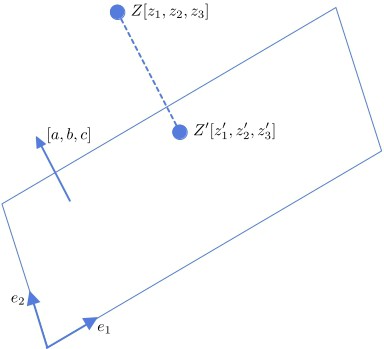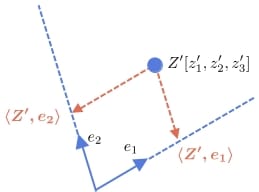1. Introduction
In this tutorial, we’ll explain how to project a three-dimensional point onto a (two-dimensional) plane with its coordinate system.
2. Setup
Let’s say we have a point with coordinates and a plane whose equation is:
(1)
where is any point in the plane, and
are its parameters. Geometrically,
is the vector normal to the plane. It doesn’t have to be unitary but needs to be non-zero. Parameter
is the
-coordinate of the plane’s intersection with the
-axis. Visually:

The plane has a two-dimensional coordinate system of its own, defined by two base unit vectors and
.
So, our goal is to find the coordinates of the ‘s projection
onto the plane in the coordinate system defined by
and
.
3. How to Project a Point
Let’s start by projecting onto the plane and finding the coordinates in the original 3D system. Since the projection
belongs to the plane, its coordinates fit Equation (1):
(2)
Further, the line connecting and
is perpendicular to the plane, so it’s parallel to the plane’s normal vector. The line’s vector is
. So, the following should hold:
(3)
for some real number .
By solving (3) for ,
, and
, and plugging the obtained expressions into Equation (2), we get:
If the normal vector is also a unit vector (i.e., its length is 1), the denominator is also one since it denotes the vector’s squared length.
By substituting in Equations (2), we can easily calculate the coordinates:
3.1. Example
Let and let the plane’s equation be:
For , we get:
So, the projection is
.
3.2. An Alternative Parameterization of the Plane
The plane can be specified by the normal vector and a point
in it. For an arbitrary point
in the plane, it must hold that the vector
is perpendicular to
:
Therefore:
This is the same as Equation (??) if we set . So, after computing
, we can proceed as in the sections above.
4. Finding New Coordinates
We get the new coordinates of by projecting it onto the unit vectors
and
:

To do that, it’s sufficient to find the dot products and
.
Now, let’s suppose that and
. If we treat all the vectors (including points) as column vectors, we can get the new coordinates of
by matrix multiplication:
(4)
4.1. Example
Let’s say that is
,
, and
:
The coordinates of in the new coordinate system are
.
5. Conclusion
In this article, we showed how to project a point onto a plane and find its coordinates in the plane’s coordinate system.